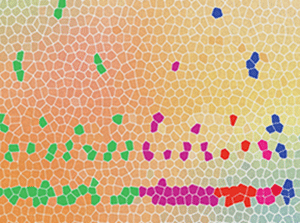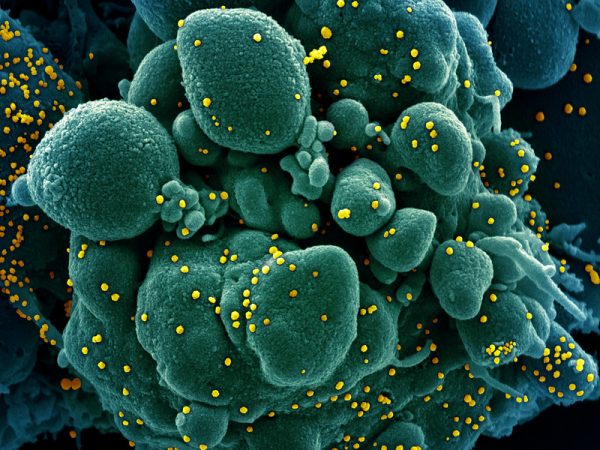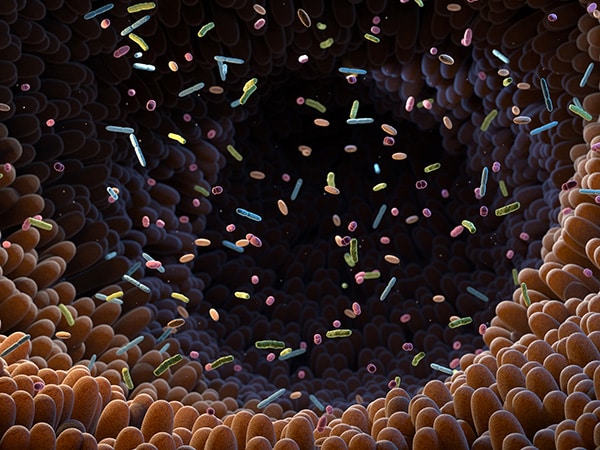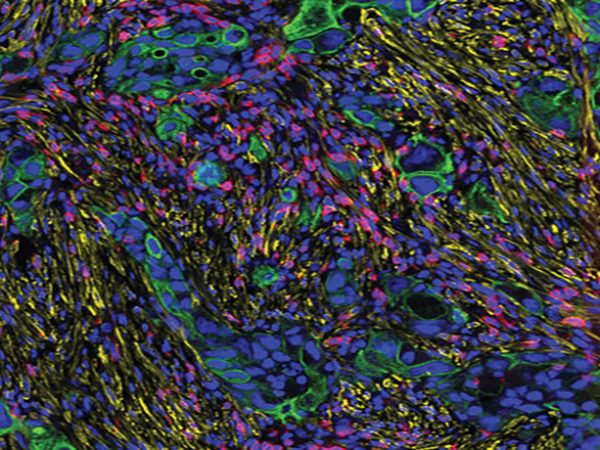AACR Editors Share Latest Selection of Journal Articles
As we keep an eye out for those promised May flowers, we bring you the latest round of Editors’ Picks from the editors of the AACR journals. This group of selected articles includes data from two clinical trials, a study on how mutations during fetal development affect cancer risk, and an evaluation of sex-related differences in the efficacy of aspirin in gastric cancer prevention, among others. As always, these articles are free to access online for a limited time.
Journal: Molecular Cancer Therapeutics
(+)-JJ-74–138 is a Novel Noncompetitive Androgen Receptor Antagonist
The development and progression of prostate cancer is largely driven by androgen receptor (AR). Androgen deprivation therapy (ADT) with antagonists that compete with dihydrotestosterone for binding to the ligand-binding domain of AR and block AR-mediated signaling, is a standard treatment for metastatic prostate cancer. However, after an initial response, in most cases the disease progresses to become castration-resistant prostate cancer (CRPC), underscoring a pressing need to identify novel antagonists that inhibit AR in different ways. The authors of this study developed a candidate compound called (+)-JJ-74–138 that can inhibit AR lacking the ligand-binding domain. In vitro studies showed that (+)-JJ-74–138 caused nuclear degradation of unliganded, full-length AR, decreased AR binding to androgen response elements, and inhibited the transcriptional activity of both AR and the ARv7 splice variant. In addition, the compound inhibited the growth of xenograft tumors. The authors suggested that (+)-JJ-74–138 may be a promising novel noncompetitive AR antagonist for treating enzalutamide-resistant CRPC. This study was highlighted and featured on the cover of the April issue.
Journal: Cancer Prevention Research
Association Between Aspirin Use and Gastric Adenocarcinoma: A Prospective Cohort Study
Aberrant production of hormones called prostaglandins is associated with the development of gastric cancer. Researchers have speculated that aspirin, which can block prostaglandin synthesis, may prevent gastric cancer development, but large prospective studies in this area are limited. In this study, researchers evaluated the association between regular aspirin use and incidence of gastric cancer in 159,116 individuals from the Nurses’ Health Study and the Health Professionals Follow-up Study. After adjusting for factors such as age, race, body mass index, alcohol intake, smoking history, and use of other medications, the researchers found that women who regularly used aspirin had a 48 percent decreased risk of gastric cancer. This effect was dose-dependent, with the greatest effect in women taking five or more tablets per week, and time-dependent, with the greatest effect in women taking aspirin regularly for 10 or more years. In men, however, aspirin was not associated with a significant change in gastric cancer incidence. These data suggest that regular aspirin use may be a promising chemopreventive strategy for gastric cancer in women, and that more research is needed to understand the sex-related differences underlying this effect. A related commentary is available here.
Journal: Blood Cancer Discovery
Physicians use the cytokine IFNγ as a marker of successful engraftment of CAR T cells and have long believed that IFNγ is crucial to the antitumor effects of CAR T-cell therapy. However, IFNγ can also stimulate systemic side effects such as cytokine release syndrome (CRS), making it an attractive target to mitigate toxicity. In this study, the researchers showed that genetic deletion of IFNγ or pharmacological inhibition with an anti-IFNγ antibody did not diminish the ability of CAR T cells to attack leukemia and lymphoma cells, either in vitro or in an in vivo cell xenograft mouse model. Further, they found that knocking out IFNγ in CAR T cells decreased the expression of inhibitory immune checkpoint proteins, especially in CAR T cells that express the CD28 costimulatory domain. Using patient data, the researchers confirmed a correlation between high IFNγ levels and incidence of CRS. They then developed an in vitro system and a hybrid in vitro/in vivo system to model the effects of IFNγ on macrophages, which produce many of the cytokines involved in CRS. They found that conditioned media or mouse serum with low IFNγ stimulated less macrophage activation and decreased secretion of CRS-related cytokines. This data suggests that pharmacological inhibition of IFNγ may protect against CRS and boost CAR T-cell efficacy without compromising CAR T-cell function. This study is featured on the cover of the April issue, and a related research article is available here.

Journal: Cancer Discovery
Cancer-Causative Mutations Occurring in Early Embryogenesis

Germline mutations in cancer susceptibility genes (CSGs) are associated with hereditary syndromes characterized by elevated cancer risk. Somatic mutations occurring during embryonic development can also affect CSGs and give rise to somatic mosaicism, or the presence of two or more cell populations with different genotypes in the same individual. This phenomenon has been associated with cancer predisposition syndromes, but its contribution to sporadic cancers was unknown. The authors of this study analyzed sequencing data of paired blood and tumor tissues from more than 35,000 patients with apparently sporadic cancers. They detected 36 pathogenic mosaic variants in CSGs, including TP53 and RB1, most of which had been missed by clinical genetic testing. These CSG mosaic variants were found in normal tissues with different embryonic origin, indicating they occurred early during embryogenesis. Analysis of tumor samples from patients affected by the CSG mosaic variants revealed that biallelic inactivation occurred in 91.7 percent of cases and that the pathologic and genomic features of the tumors were consistent with inactivation of the corresponding CSG. According to the authors, this study provides a comprehensive analysis of mosaicism affecting CSGs in a large patient population using a clinical-grade sequencing assay and highlights a previously underestimated contribution of mosaic CSG variants to the development of seemingly sporadic cancers. This article was featured on the cover of the April issue and a commentary is available here.
Journal: Clinical Cancer Research (April 15 issue)
Estrogen deprivation via endocrine therapy is the standard of care for the treatment of hormone receptor (HR)-positive, HER2-negative breast cancer, the most common breast cancer subtype. Resistance to endocrine therapy is common and stems from different mechanisms, including mutation of the estrogen receptor (ER) gene ESR1 and the PIK3CA gene. In this study, the authors analyzed the baseline circulating tumor DNA of a subgroup of patients enrolled in the MONARCH 2 trial to assess the mutational status of ESR1 and PIK3CA. MONARCH 2 was a randomized, double-blind phase III trial that led to the approval of the CDK4/6 inhibitor abemaciclib (Verzenio) in combination with the selective ER degrader fulvestrant in patients with HR-positive, HER2-negative advanced breast cancer that had progressed on previous endocrine therapy. The objective of this exploratory analysis was to assess the efficacy of the combination in patients with or without PIK3CA or ESR1 mutations. Abemaciclib plus fulvestrant improved progression-free survival and overall survival compared with placebo plus fulvestrant regardless of the presence of ESR1 and PIK3CA mutations. This study was highlighted in the April 15 issue.
Journal: Cancer Research (April 1 issue)
Disrupting the MYC-TFEB Circuit Impairs Amino Acid Homeostasis and Provokes Metabolic Anergy
To meet their increased energy demand and adapt to changes in the tumor microenvironment, cancer cells need to constantly adjust their metabolism. This includes maintaining sufficient pools of amino acids to support protein synthesis. The MYC oncoprotein plays a key role in regulating metabolic reprogramming in cancer cells. In this study, the authors report a new mechanism through which Myc regulates amino acid metabolism by controlling the autophagy pathway in Myc-driven lymphoma. Study results showed the existence of a mutual regulation circuit between Myc and transcription factor EB (TFEB), a master regulator of autophagy, whereby Myc suppressed TFEB expression and function in primary mouse B cells and B-cell lymphoma, and TFEB antagonized MYC transcription programs. Accordingly, autophagy was suppressed in Myc-driven lymphoma. As compensatory mechanisms to maintain the amino acid pools, elevated expression of proteasome components, increased proteasome activity, and upregulation of amino acid transport were observed in Myc-expressing B cells. Furthermore, reactivation of the autophagy pathway by restoring TFEB function disrupted mitochondrial functions, proteasome activity, and amino acid transport and metabolism, which led to metabolic anergy, growth arrest, and cell death. According to the authors, these results suggest that activation of TFEB or the proteasome might represent new therapeutic options for Myc-driven malignancies, while inhibition of autophagy would likely have no benefit.
Journal: Cancer Epidemiology, Biomarkers & Prevention
Research has shown that benzene, a solvent in chemical and pharmaceutical products, is causally related to acute myeloid leukemia (AML). However, the amount of exposure that raises risk of developing AML has not been fully established. Risk assessment studies may benefit from integrating data from multiple evidence bases, especially for rare conditions or when data are sparse. In this study, researchers integrated data from 26 studies—six human epidemiological studies on AML, three human leukemia studies that did not include AML, 10 biomarker studies, and seven animal studies—to estimate an exposure-response curve measuring the risk of developing AML after benzene exposure. They created multiple models to measure the relative risk of developing AML at various levels of benzene exposure, cross-validating them to compare the quality of the models. The researchers determined that a linear model with intercept provided the best predictions, compared with splice models. While more research is required on the best approaches to extrapolating data from animal studies to the human setting, the study provides a model for the quantitative integration of human and animal data. This article was highlighted in the April issue and a related commentary is available here.
Journal: Cancer Research (April 15 issue)
Cancer-associated fibroblasts (CAF) are one of the major components of the tumor microenvironment (TME). They affect the antitumor immune response by promoting infiltration of immunosuppressive cells via secretion of cytokines such as CXCL12. Previous research has shown that ketogenic diets, based on high fat and low carbohydrate intake, have inhibitory effect on tumor growth in vivo and enhance the anticancer activity of immune checkpoint blockade therapy in mouse models of colorectal cancer and other cancers. However, how ketogenesis affects the immunosuppressive TME is not known. In this study, the authors dissected the effects of ketogenic diet on the colorectal cancer TME and showed that it results in reduced infiltration of immunosuppressive cells and increased infiltration of natural killer and cytotoxic T cells. Increasing ketogenesis by overexpressing a ketogenic enzyme in a CAF cell line resulted in reduced CXCL12 production via downregulation of the transcription factor KLF5 that binds the CXCL12 promoter and promotes its expression. Furthermore, treatment with the ketone body b-hydroxybutyrate reduced CAF growth in vitro. In vivo, ketogenic diet repressed the expression of CXCL12, enhanced the antitumor effects of anti-PD1 therapy in colorectal tumor models, and inhibited lung metastasis. Results also showed that ketogenesis is downregulated in colorectal cancer tissues from patients. According to the authors, these findings provide a novel metabolic strategy to modify the immunosuppressive TME by reducing CXCL12 expression, and demonstrate the potential of using ketogenic diet to enhance the efficacy of immunotherapy for metastatic colorectal cancers. A commentary on this study can be found here.
Journal: Molecular Cancer Research
MIRO2 Regulates Prostate Cancer Cell Growth via GCN1-Dependent Stress Signaling
No effective treatments are available for patients with metastatic castration-resistant or androgen receptor-independent prostate cancer, highlighting the need to identify novel therapeutic targets. The authors of this study focused on a novel mitochondrial pathway centered on mitochondrial Rho GTPase 2 (MIRO2), a small GTPase of the Ras superfamily that has been implicated in cancer. The results showed that MIRO2 mRNA was upregulated in prostate tumors from patients with recurrent, progressive, or metastatic disease, and that higher MIRO2 expression correlated with poor survival. In preclinical studies, MIRO2 depletion impaired cell growth and colony formation in vitro and tumor growth in mice. The authors also analyzed MIRO2 protein interactions and revealed that general control nonderepressible 1 (CGN1), which is also overexpressed in prostate cancer, interacts with MIRO2. MIRO2 mutations identified in patients caused increased MIRO2-CGN1 binding. Consequently, MIRO2 activated the general control nonderepressible 2 (GCN2)/activating transcription factor 4 (ATF4) signaling axis, resulting in increased expression and transcriptional activity of ATF4, which the authors characterized as the main mediator of MIRO2-dependent regulation of prostate cancer cell growth. Finally, both MIRO2 and GCN2 levels were found to be higher in hypoxic areas of prostate cancer xenografts, suggesting that hypoxia may drive MIRO2/GCN1/GCN2 pathway activation in vivo. Based on these findings, the authors proposed that targeting the MIRO2-GCN1 axis may represent a new strategy to inhibit prostate cancer growth. This study was highlighted in the April issue.
Journal: Cancer Immunology Research
Small, specialized blood vessels called high endothelial venules (HEVs) bring naïve immune cells to lymphoid organs such as the tonsils and lymph nodes. These venules can also form in some tumors and have been associated with improved patient prognosis and better response to immunotherapy in mice. In this study, the authors compared the gene expression profiles of cells from HEVs with the profiles of cells from other tumor-associated blood vessels to establish potential transcriptomic biomarkers of prognosis and immunotherapy response. The researchers performed RNA sequencing on HEVs and non-HEV vessels from eight breast cancer patients. They found 35 significantly upregulated genes and 41 significantly downregulated genes in HEVs compared to other vessels, including genes known to be differentially regulated in lymph node HEVs. High expression of MEOX2 and TSPAN7, two genes that are upregulated in HEVs, was associated with the development of T-cell and B-cell clusters called tertiary lymphoid structures, which correlate with increased immune infiltration and improved response to immune checkpoint inhibitors. Using publicly available gene expression data, the researchers confirmed that patients whose breast tumors highly expressed MEOX2 and/or TSPAN7 had a significantly longer five-year and eight-year survival than patients with low expression of these genes. The authors suggest that MEOX2 and TSPAN7 expression could potentially indicate the presence of HEVs and serve as a biomarker of prognosis and immunotherapy response. A related commentary is available here.
Journal: Clinical Cancer Research (April 1 issue)
HER2-targeted therapies are standard of care in breast cancer with HER2 gene amplification. Although tumor cells harboring HER2 mutations are sensitive to the HER2 inhibitor neratinib (Nerlynx) in vitro, neratinib monotherapy has shown modest activity in HER2-mutated (HER2mut) breast cancer patients without HER2 amplification, which led to studies of combination therapies to improve efficacy. HER2 mutations have been shown to occur predominantly in ER-positive breast cancer and represent a mechanism of resistance to endocrine therapy. Furthermore, combining endocrine therapy and neratinib resulted in additive antitumor effects in preclinical models. The authors of this study conducted the single-arm, phase II MutHER study of neratinib in combination with fulvestrant in patients with ER-positive/HER2mut, non-amplified metastatic breast cancer. The study included two cohorts of patients who had previously received or not received fulvestrant (FUL-treated and FUL-naïve, respectively), and an exploratory ER-negative (ER−)/HER2mut cohort. The clinical benefit rate (CBR) was 38 percent, 30 percent, and 25 percent in the FUL-treated, FUL-naïve, and ER−/HER2mut cohorts, respectively. Lobular histology that correlates with poor survival was particularly responsive to the treatment, while the L755 mutation, the most common HER2 mutation in breast cancer, was associated with lower efficacy. Acquired HER2mut were detected in five of 23 patients at progression. Adding trastuzumab (Herceptin) in five patients whose disease progressed on neratinib resulted in three partial responses and one stable disease that lasted more than 24 weeks. This was associated with a significant reduction or elimination of HER2 mutations detected in ctDNA, including those acquired at progression on neratinib. The study did not meet the predefined criteria to support the combination of neratinib and fulvestrant relative to neratinib alone. However, according to the authors, the results indicated the sensitivity of the poor prognosis lobular histology to neratinib plus fulvestrant and support further studies of the neratinib and trastuzumab combination in HER2mut metastatic breast cancer. This study was highlighted in the April 1 issue.



